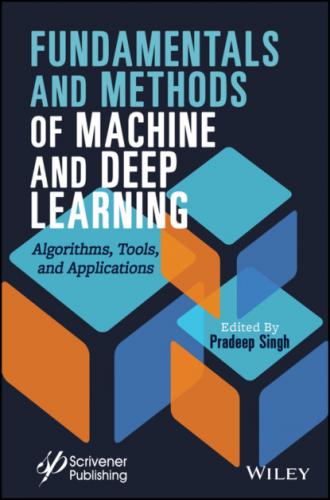21 17 Assistive Technologies for Visual, Hearing, and Speech Impairments: Machine Learning and Deep Learning Solutions 17.1 Introduction 17.2 Visual Impairment 17.3 Verbal and Hearing Impairment 17.4 Conclusion and Future Scope References
22 18 Case Studies: Deep Learning in Remote Sensing 18.1 Introduction 18.2 Need for Deep Learning in Remote Sensing 18.3 Deep Neural Networks for Interpreting Earth Observation Data 18.4 Hybrid Architectures for Multi-Sensor Data Processing 18.5 Conclusion References
23 Index
Guide
1 Cover
5 Preface
7 Index
List of Illustrations
1 Chapter 1Figure 1.1 Linear regression [3].Figure 1.2 Height vs. weight graph [6].Figure 1.3 Logistic regression [3].Figure 1.4 SVM [11].Figure 1.5 Decision tree.
2 Chapter 2Figure 2.1 A high-level representation of Bayes optimal classifier.Figure 2.2 A high-level representation of Bootstrap aggregating.Figure 2.3 A high-level representation of Bayesian model averaging (BMA).Figure 2.4 A high-level representation of Bayesian classifier combination (BCC).Figure 2.5 A high-level representation of bucket of models.Figure 2.6 A high-level representation of stacking.
3 Chapter 3Figure 3.1 ML/DL model deployment process.Figure 3.2 Residual.Figure 3.3 Confusion metric.Figure 3.4 Confusion metric interpretation.Figure 3.5 Metric derived from confusion metric.Figure 3.6 Precision-recall trade-off.Figure 3.7 AUC-ROC curve.Figure 3.8 Precision-recall curve.Figure 3.9 Confusion metric example.Figure 3.10 Cosine similarity projection.Figure 3.11 (a) Cosine similarity. (b) Soft cosine similarity.Figure 3.12 Intersection and union of two sets A and B.Figure 3.13 Confusion metric.
4 Chapter 4Figure 4.1 Cases in Karnataka, India.Figure 4.2 Cases trend in Karnataka, India.Figure 4.3 Modified SEIR.Figure 4.4 LSTM cell.Figure 4.5 (a) Arrangement of data set in 3D tensor. (b) Mapping of the 3D and 2...Figure 4.6 RMSLE value vs. number of epochs.Figure 4.7 Cases in Karnataka.Figure 4.8 SEIR Model fit for test cases.Figure 4.9 Cases predicted for next 10 days.Figure 4.10 Testing results.Figure 4.11 Next 10 days Prediction using LSTM model.Figure 4.12 Prediction error curve.Figure 4.13 Prediction error and RMSLE curve.
5 Chapter 5Figure 5.1 Classification of feature extraction methods.
6 Chapter 6Figure 6.1 Relationship between AI, ML, and DL.Figure 6.2 Image segmentation process flow.Figure 6.3 The visual representation of clinical data generation to natural lang...
7 Chapter 7Figure 7.1 Extraction of exudates.Figure 7.2 Extraction of blood vessels.Figure 7.3 Extraction of microaneurysms.Figure 7.4 Extraction of hemorrhages.Figure 7.5 Working of AdaBoost model.Figure 7.6 Working of AdaNaive model.Figure 7.7 Working of AdaSVM model.Figure 7.8 Working of AdaForest model.Figure 7.9 Representative retinal images of DR in their order of increasing seve...Figure 7.10 Comparison of classifiers using ROC curve (Binary classification).Figure 7.11 Comparison of classifiers (Binary Classification).Figure 7.12 Comparison of classifiers (Multi Classification).
8 Chapter 8Figure 8.1 Workflow model of proposed system.Figure 8.2 Architecture of proposed system.Figure 8.3 Original dataset distribution.Figure 8.4 Resampling using SMOTE.Figure 8.5 Target class distribution.Figure 8.6 Resampled distribution applying SMOTE.Figure 8.7 Feature ranking using Extra tree classifier.Figure 8.8 p-values of the features.Figure 8.9 Performance evaluation of models under study 1 with dataset size = 1,...Figure 8.10 Performance evaluation of models under study 2 with data size = 1,00...Figure 8.11 Performance evaluation of models under study 3 With dataset size = 1...Figure 8.12 Correlation between follow-up time and death event.Figure 8.13 Performance evaluation of models on different classifiers.Figure 8.14 Performance evaluation of models on dataset size = 508.Figure 8.15 Performance evaluation of models on dataset size = 1,000.
9 Chapter 9Figure 9.1 File level defect prediction process.Figure 9.2 A basic convolutional neural network (CNN) architecture.Figure 9.3 Overall network architecture of proposed NCNN model.Figure 9.4 Description regarding confusion matrix.Figure 9.5 Confusion matrix analysis for the data sets (KC1, KC3, PC1, and PC2).Figure 9.6 Model accuracy and model loss analysis for the data sets (KC1, KC3, P...Figure 9.7 Performance comparison of different models for software defect predic...Figure 9.8 Model accuracy analysis for the data sets (KC1, KC3, PC1, and PC2).Figure 9.9 Confusion rate analysis for the data sets (KC1, KC3, PC1, and PC2).
10 Chapter 10Figure 10.1 Hierarchical video representation.Figure 10.2 Overall architecture of the proposed framework.Figure 10.3 Blocking pattern.Figure 10.4 Key frame extraction.Figure 10.5 Training and testing process.Figure 10.6 Predicted output frames from advertisement videos.Figure 10.7 Predicted output frames from non-advertisement videos.
11 Chapter 11Figure 11.1 Flowchart of proposed architecture.Figure 11.2 Architecture of proposed combinational CNN+LSTM model.Figure 11.3 Overall XceptionNet architecture.Figure 11.4 Proposed CNN model’s accuracy graph on (a) MindBig dataset and (b) P...Figure 11.5 Proposed CNN+LSTM model’s accuracy graph on (a) MindBig dataset and ...
12 Chapter 12Figure 12.1 Flow diagram of the credit card fraudulent transaction detection.Figure 12.2 Correlation matrix for the credit card dataset showing correlation b...Figure
